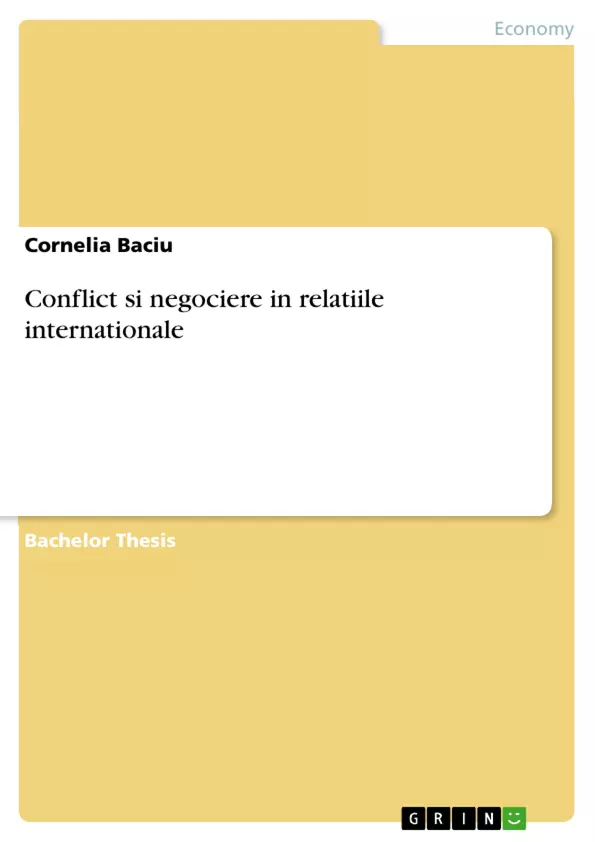În prezenta teză de licenţă voi prezenta perspectivele conflictului internaţional, a rezoluţiei sale şi a procesului de menţinere a păcii prin metoda negocierii internaţionale. Nu există nici o regulă generală care să indice de către cine ar trebui implementate mijloacele de menţinere a păcii. Atât forţa, cât şi raţionamentul reprezintă ultimul resort, o alternativă omniprezentă pentru stimularea instrumentelor multilaterale de „rezoluţie alternaţivă a conflictului” prin dialog, mediere, convingere şi negociere. Este imposibil de recomandat care dintre aceste metode şi tehnici ar trebui să fie utilizată prima; cea mai atrăgătoare perspectivă ar fi să fie testate – sau, cel puţin, evaluate – toate, pentru a putea fi consolidată una din ele. De asemenea, nu există o interclasare nici în privinţa agenţilor – aceştia pot fi constituiţi de Naţiunile Unite, organizaţii locale sau regionale sau coaliţii statale neoficiale. Oraganizaţiile locale sau regionale şi coaliţiile statale pot iniţia activitatea pentru acţiunile oficiale şi pot fi utile pentru stimularea birocraţiilor diplomatice lente către angrenajul propriu-zis. Atunci câns statele preiau procesul de menţinere a păcii, exercitând întâi iniţiative unilaterale şi abia apoi acumulând suport multilateral, organizaţiile de diferite tipuri joacă un rol important ca parte integrantă din procesul general. Atunci când eforturile sunt încununate de succes, atât statele cât şi organizaţiile locale sau regionale şi coaliţiile statale trebuie să rămână implicate, denotând fiecare un comportament efectiv. Procesul de menţinere a păcii este unul colectiv şi o chestiune cu o dinamică continuă.
Inhaltsverzeichnis
- Introducere
- Capitolul 1. Opțiuni de menținere a păcii în perspectiva şcolilor internaționale de gândire
- 1.1. Tradiția idealistă: spre o pace liberală
- 1.2. Agenda realistă pentru pace: supraviețuire şi pacea învingătorului
- 1.3. Impactul structuralismului. Agenda marxistă pentru pace : spre o pace – justiție socială şi emancipare
- 1.4. Contribuțiile post-structuraliste la conceptul de pace
- Capitolul 2. Conflictul internațional
- 2.1. Dinamica evoluției conflictului internațional
- 2.2. Dimensiuni socio-psihologice ale conflictului internațional
- 2.2.1. Conflictul ca şi proces determinat de nevoi şi temeri colective
- 2.2.2. Conflictul ca proces intersocietal
- 2.2.3. Conflictul ca proces multilateral de influență mutuală
- 2.2.4. Conflictul ca şi proces interactiv, cu o dinamică escalatorie autoperpetuantă
- Capitolul 3. Negocierea în relațiile internaționale
- 3.1. Patru perspective ale negocierii
- 3.1.1. Negocierea ca proces de rezolvare a puzzle-ului
- 3.1.2. Negocierea ca tranzacție
- 3.1.3. Negocierea ca proces organizațional
- 3.1.4. Negocierea ca și politică diplomatică
- 3.2. Strategii de negociere
- 3.3. O perspectivă praxiologică asupra negocierii
- 3.3.1. Negocierea confruntațională versus negocierea integrativă
- 3.3.2. Dilema negocierii
- 3.3.3. Sfaturi practice
- Studiu de caz: Menținerea internațională a păcii
Zielsetzung und Themenschwerpunkte
Die Arbeit zielt darauf ab, die Perspektive des internationalen Konflikts und seiner Lösung sowie den Prozess der Friedenswahrung durch die Methode der internationalen Verhandlungen zu beleuchten. Die Arbeit analysiert verschiedene Schulen des Denkens, die sich mit Friedensoptionen auseinandersetzen, untersucht die Ursachen und Faktoren, die internationalen Konflikten zugrunde liegen, und erörtert die Verhandlung als Methode zur Konfliktlösung. Sie umfasst auch einen Fallstudienteil, der die Frage nach der Rolle verschiedener Akteure bei der Friedenswahrung, insbesondere der Vereinten Nationen, regionaler Organisationen und Ad-hoc-Koalitionen, untersucht.
- Unterschiedliche Perspektiven auf den Frieden aus verschiedenen internationalen Denkschulen
- Dynamik und Dimensionen des internationalen Konflikts
- Verhandlung als Instrument zur Konfliktlösung
- Rolle verschiedener Akteure bei der Friedenswahrung
- Praktische Aspekte der Verhandlungsführung
Zusammenfassung der Kapitel
Das erste Kapitel befasst sich mit verschiedenen Perspektiven auf den Frieden, die von vier internationalen Denkschulen vertreten werden: Idealismus, Realismus, Structuralismus und Post-Structuralismus. Das zweite Kapitel analysiert die Dynamik der Entwicklung des internationalen Konflikts und seine sozio-psychologischen Dimensionen aus vier unterschiedlichen Perspektiven: Konflikt als (1) ein durch kollektive Bedürfnisse und Ängste bestimmter Prozess, (2) ein intergesellschaftlicher Prozess, (3) ein multilateraler Prozess gegenseitigen Einflusses, (4) ein interaktiver Prozess mit einer eskalierenden und sich selbst erhaltenden Dynamik. Das dritte Kapitel beleuchtet vier Aspekte des Verhandlungsprozesses in den internationalen Beziehungen: Verhandlung als Problemlösungs-prozess, als Transaktion, als Organisationsprozess und als diplomatische Politik. Es umfaßt ebenso sieben konkrete Verhandlungsstrategien und einen praxisorientierten Überblick über die Verhandlung, der sich mit der konfrontativen Verhandlung versus der integrativen Verhandlung, der Darstellung der Verhandlungsdilemma und praktischen Ratschlägen für Verhandlungspartner befasst. Die Fallstudie hat zum Ziel, die Frage zu beantworten, ob die internationale Friedenswahrung von den Vereinten Nationen, regionalen Organisationen (z.B. OAS, OAU/AU, ECOWAS, EU, OSCE oder NATO) oder von Ad-hoc-Koalitionen auf Wunsch der Staaten durchgeführt werden soll.
Schlüsselwörter
Internationale Beziehungen, Frieden, Konflikt, Verhandlung, Denkschulen, Idealismus, Realismus, Structuralismus, Post-Structuralismus, Friedenswahrung, Vereinte Nationen, regionale Organisationen, Strategien, Dilemma, praktische Ratschläge.
- Quote paper
- Cornelia Baciu (Author), 2009, Conflict si negociere in relatiile internationale, Munich, GRIN Verlag, https://www.grin.com/document/148664



